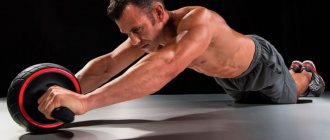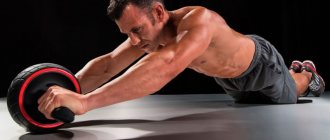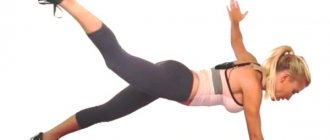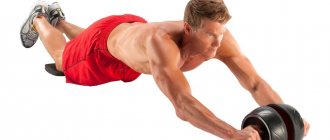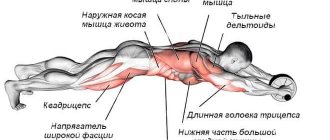Share:
Ab crunches are an exercise performed by athletes to gain strong and sculpted abs. According to its biomechanics, it represents an elevation of the torso with a slight rounding of the back (kyphosis) in the thoracic region from a lying position. As a rule, crunches are not performed by the athlete in the maximum possible amplitude, so that the load is constant and the abdominal muscles do not relax at the top and bottom points. Working in a similar technique, the load is focused on the upper part of the rectus abdominis muscle.
This exercise has gained well-deserved popularity among athletes involved in crossfit, bodybuilding, fitness and martial arts, since a well-developed abdominal press plays an important role in all these disciplines. And today we will tell you how to do crunches correctly - all possible variations of this exercise.
What are the benefits of abdominal crunches?
I would like to note right away that crunches are not an exercise identical to sit-ups or sit-ups. In crunches, the amplitude is not so important to us; here there is absolutely no point in lifting the body to a right angle, but rather the continuous work of the abdominal muscles and control of movement - for this we slightly round the back in the thoracic region. This slight kyphosis is acceptable and does not increase the risk of injury.
The good thing about crunches is that by choosing one or another type of crunch that we will do in training, we can regularly add variety to the training process and work out certain parts of our abdominal muscles in isolation.
Because of this, I consider crunches the #1 exercise for developing abdominal muscles. It is quite simple, it is easy to feel the contraction and stretching of the working muscle group, most of its types do not require additional equipment, and with the help of crunches you can properly work out the muscles of your abs in just 10-15 minutes - an excellent option for those people who cannot devote much time to training.
© Makatserchyk — stock.adobe.com
Why you need to strengthen your abdominal muscles
The abdominal muscles are often called the “basis of vitality” of a person. This is partly true, since developed abdominal muscles significantly improve the quality of life at any age, especially after 50-60 years. The main reasons to strengthen your abs:
- Health and protection of internal organs, preventing their prolapse.
- Maintaining spinal health, improving posture.
- Preventing the risk of hernias and protrusions, as well as reducing the risk of exacerbation of existing diseases.
- Improved functionality and fitness.
- Creating an attractive appearance of the abdomen, improving the relief and visual delineation of the muscles.
In general, the stomach is one of the most important areas, after the head. It contains vital organs, the spine, which is largely responsible for human mobility. Also, the abdominal muscles are a kind of “bridge” for transmitting impulses between the upper and lower extremities. In weightlifting, crossfit, fitness, martial arts, the stomach plays a key role. Therefore, strengthening the abdominal muscles is brought to the fore in the training scheme.
Types and technique of performing exercises
Let's look at how to properly do the most famous types of crunches, starting from the more basic, effective and common ones.
Classic crunches
The simplest variation of abdominal crunches from the point of view of following the correct technique is the classic one. The athlete performing the exercise lifts the body, slightly bent at the top (the area of the shoulder blades and latissimus dorsi), from a lying position. This is done as follows:
- Starting position: the athlete lies down on the floor or fitness mat, legs bent at the knees, feet firmly on the floor, hands behind the head.
- As you exhale, smoothly lift your upper body without changing the position of your lower back and buttocks - they remain firmly pressed to the floor. The upper back should be slightly rounded, this will make it easier for you to concentrate on contracting the abdominal muscles.
- Smoothly continue lifting your torso until you feel the load reach its peak. Hold this position for a second to further statically contract the muscles.
- Start going down. The lowering of the body must be controlled. It is not necessary to lower yourself completely to the floor; it is better to stop about ten centimeters from it, when the abdominal muscles are most stretched. Working in such a reduced amplitude, you will increase the effectiveness of this exercise, since the load will be many times more intense.
Reverse crunches
An equally effective type of exercise is reverse abdominal crunches, which emphasize the bulk of the load in the lower part of the abs. The fundamental difference with the classic version is that in reverse crunches we contract the abs by lifting the legs, not the body. Reverse crunches can be performed either lying on the floor or lying on a special bench with your head up - there are no fundamental differences. This is done as follows:
- Starting position: the athlete lies on the floor or on an inclined bench, holding its upper edge with his hands. If you are doing the exercise on the floor, it is recommended to keep your arms straight down, they will help you better control the movement. Your legs should be slightly bent at the knees.
- Begin to raise your legs up, while exhaling and smoothly lifting your lower back from the surface - this will ensure the best contraction of the abdominal muscles.
- Gently lower your legs and lower back down while inhaling. It is better to work here according to the same scheme as in ordinary crunches - in a shortened amplitude with constant muscle tension.
© Makatserchyk — stock.adobe.com
Incline crunches
Almost every modern gym is equipped with a special bench with an incline of about 30 degrees for working out the abs, why not take advantage of it? Moreover, the exercise is as effective as classic lying crunches. This is done as follows:
- Starting position: sit on an incline bench, secure your legs between the bolsters at the top of the bench, cross your arms over your chest.
- As you exhale, begin to twist, slightly rounding your upper back. The biomechanics of crunches on an incline bench are almost identical to the classic version, so here we work in the same amplitude.
- Smoothly lower down, inhaling. Here you can work in the maximum possible amplitude with a slight delay on the bench, so it will be easier to “squeeze” the rectus abdominis muscle, each time starting the movement from the starting position. More experienced athletes can work this exercise using additional weights, holding a barbell disc or small dumbbell in their hands at solar plexus level.
Standing cable crunches
An interesting option for those who want to diversify their workload. The advantage of the block exercise machine is that the load is continuous, and the muscles are statically tense even in the top position. This is done as follows:
- Starting position: stand with your back to a block trainer or crossover, grab the handle with both hands (it’s most convenient to do it with a cable handle), place the handle behind your head at neck level.
- Start moving your body down, rounding the area of your shoulder blades and tensing your abdominal muscles. You should lower yourself until your elbows touch your thighs. Take a short break in this position. Of course, the weight in the simulator should be set to low, otherwise you risk getting a spinal injury.
- As you inhale, smoothly begin to bend back while straightening your back. Here we work at full amplitude; a slight delay at the starting point is acceptable.
Crunches in a block machine while standing on your knees
Kneeling cable crunches are another exercise variation that requires an overhead pulley. The difference lies in the amplitude - here it is shorter, so it will be easier for many to feel the contraction of the abdominal muscles in this version. This is done as follows:
- Starting position: position yourself facing the pulley machine, grab the rope handle, and kneel down with it. Keep your back vertical and straight, and look forward.
- Begin to lower your body down, rounding your back and exhaling. As with standing crunches, try to touch your elbows to your feet. Hold this position for a moment, further tensing your abs.
- Gradually begin to unbend. You can work in both full and shortened amplitude; try both options and choose the one in which you feel the maximum load on the abs.
© Makatserchyk — stock.adobe.com
Hanging crunches
A technically challenging but effective option for fans of old-school heavy training. Hanging upside down on the horizontal bar, it is quite difficult to concentrate on making a twisting movement rather than lifting the body, but this moment comes with experience. You should not do hanging crunches if you suffer from intracranial hypertension or increased intraocular pressure - this can aggravate the problem. This is done as follows:
- Starting position: the athlete hangs on the bar with bent legs, the whole body is lowered down, the back is straight, the hands are brought together at the back of the head. It is important that in the starting position the body does not sway and there is no inertia.
- Begin to lift your body up, exhaling, rounding your back and lifting your buttocks slightly up. Do not try to work at full amplitude and try to reach your knees with your head - there is little point in this. It is better to work up to approximately the level of parallel with the ground, at this moment the tension in the abdominal muscles will be maximum.
- Slowly lower yourself down while inhaling. If necessary, stay in the lower position for a couple of seconds to completely extinguish the inertia; start the movement from a stationary state.
Oblique crunches
This variation of the crunch places the bulk of the load on the obliques, making oblique crunches a great addition to any core exercise that uses the rectus abdominis. This is done as follows:
- Starting position: the athlete lies on the floor, legs bent at the knees, feet pressed to the floor, arms crossed at the back of the head. We place the ankle of one leg on the knee of the other.
- We begin to move the body upward, exhaling and turning the body slightly to better feel the contraction of the oblique abdominal muscles. Try to reach the knee of your left leg with the elbow of your right hand. After this, switch your legs and try to reach the knee of your right leg with the elbow of your left hand.
- We do not go down completely, we work in a shortened amplitude, the oblique muscles should be “squeezed” throughout the entire approach.
© Andrey Popov — stock.adobe.com
Crunches with legs raised
A very interesting exercise due to the combination of static and dynamic loads; the abs are tense throughout the entire approach. This is done as follows:
- Starting position: the athlete lies on the floor, his back pressed to the floor. We raise our legs up so that they are approximately perpendicular to the body, and static tension in the lower part of the abs begins. Hands should be crossed at the back of the head.
- We begin a smooth movement of the body upward, while exhaling. We slightly round the thoracic spine and try to reach our knees with our heads. Keep your lower back motionless, without lifting it off the floor. Hold this position for a second.
- Smoothly lower down, inhaling. Here it is better to work in full amplitude, with a short pause in the starting position - this way the contraction of the abdominal muscles will be maximum.
© chika_milan — stock.adobe.com
Crunches on a fitball
If your gym has a fitball, you can diversify the load and try doing crunches on it. This exercise develops the neuromuscular connection well with the rectus abdominis, and it also statically works the buttocks and hamstrings, which will come in handy for many athletes. This is done as follows:
- Starting position: the athlete lies down on the fitball, feet resting on the floor, feet slightly apart, arms crossed at the back of the head.
- We begin to lift the body up, exhaling and slightly rounding the back. Do not let the ball change its position, this is the point of the exercise, at this moment a large number of muscles responsible for balance and stabilization are involved in the work.
- Smoothly return to the starting position, inhaling, and bend back a little to further stretch your abdominal muscles.
© Makatserchyk — stock.adobe.com
What to pay attention to
The nuances are as follows:
- We hold the weight between the back of the head and neck if we use weights.
- We rise as we exhale, we descend as we inhale.
- You can place the weight on your chest - it will be easier and safer.
- If the leg bolsters leave bruises (for girls), add a piece of foam rubber.
- You can do full or partial bends.
Body lifts on a Roman chair can be done in any yard where there are 2 adjacent pipes of different levels parallel to the ground (sit on one, secure your legs under the second).
Typical beginner mistakes
Many abdominal exercises have their own technical nuances that you need to master in order to get the most out of them. Let's look at the most common mistakes, myths and misconceptions:
- You should not train your abs more than 1-2 times a week. Crunches are a fairly easy exercise, but even after it the body needs time to recover.
- By performing a large number of repetitions, you will not burn excess fat deposits on your stomach and get the coveted “cubes”. The optimal repetition range for crunches is 12-20; in combination with a diet tailored to your goals, this approach will give maximum results.
- Do not use too heavy a weight. If you do crunches with a disc or dumbbell, do not chase the weights, it is better to focus on mental concentration and contract the abdominal muscles more isolated, but involving no assistant muscles in the work.
Recipes for healthy eating
Watermelon lollipop
- 2.6 g Protein
- 8.9 g Fat
- 9.8 g Carbohydrates
- 45.5 kcal
15-20 min.
- #watermelon
- #vegetarian dish
- #dessert
- #dietary
- #for vegans
- #coconut flakes
- #low calorie
- #pink salt
- #chocolate
Other recipes
What kind of cor? I was just going to pump up my abs
The core muscles are essentially a frame that holds the body upright and stabilizes the body during movement. Cor is responsible for:
- posture (trapezius muscles; rectus and oblique muscles, as well as the transverse abdominal muscle);
- core stabilization in upper body exercises (latissimus dorsi);
- strength in squats and running (gluteal muscles);
- stability when walking and running (hip adductors);
- back protection (quadratus lumborum);
- upright posture and stability in rotational exercises (erector spinae).
You cannot work only on the abs in isolation from other muscle groups. Training should be comprehensive and develop the body comprehensively.
Nutritional Features
Before pumping up your abs at home
, you will need to create a meal plan. Carefully consider your diet so that it includes healthy foods that relieve hunger and saturate the body with important microelements.
You will have to completely abandon the following products:
- fast foods, sweet carbonated drinks;
- flour products;
- sugar and all sweets;
- fried, smoked dishes;
- sausages;
- fatty meats and fish.
Food for mass
should consist of 20% protein foods, 30% fats and 50% carbohydrates. The diet must include fresh vegetables and fruits, which give you a feeling of fullness and do not increase weight.
Another important dietary feature is drinking plenty of water. An average person needs up to 2 liters of fluid per day. For athletes, this figure is 3 liters. Choose still, bottled water, drinking 1-2 glasses 30 minutes before meals.
If you need to burn fat
, then the serving size is reduced to 200 grams. To prevent hunger from leading to unhealthy snacks, eat 5-6 times a day.
Choosing diets and pills
for weight loss, consider their safety. Instead of a meager, tasteless mono-diet, switch to proper nutrition. And as an additional means for weight loss, choose thermogenics. For example, Nutrex Lipo-6 Black Hers Ultra Concentrate, BioTech Mega Fat Burner, Optimum Nutrition Daily Fit have proven themselves well. These are high-quality thermogenic fat burners with virtually no side effects or contraindications.
Return to article content
Include carbohydrates in your diet
Carbohydrates must be present in the diet of every athlete. But give preference to complex carbohydrates, which are absorbed slowly and give a feeling of fullness for a long time. These include fruits, vegetables and grains.
One of the favorite foods of bodybuilders is oatmeal. You can cook it with water or milk, but without adding sugar. If you need to sweeten the dish, use dried fruits or fresh fruits. It's much healthier and tastier.
Strive to completely give up sugar. This is quite simple to do by first giving up sweet tea, and then sweets and cakes. Believe me, you will quickly get used to savory dishes and even learn to fully feel their taste.
Return to article content
Eat healthy proteins
One of the misconceptions of sports beginners is replacing protein foods with protein shakes. Taking supplements is a supplement; the body should receive the bulk of the protein through food. So don't forget to use:
- beef meat;
- poultry and fish meat;
- dairy products: milk, cottage cheese, natural yogurt, kefir;
- cheese.
Return to article content
Eat in several meals
To pump up your abs, you need to form a new habit - eat often, but in small portions. Every day there should be 3 full meals: breakfast, lunch and dinner. For snacks you can use:
- nuts and dried fruits;
- freshly squeezed vegetable and fruit juices;
- protein shakes and bars;
- dairy products;
- fresh vegetables and fruits.
Avoid snacking on the go. Eating should be done in a calm environment, without emotional stress.
Return to article content
How to remove belly fat
If your primary goal is to lose weight in the abdominal area, then in addition to the exercises listed, you can perform others:
- Bike. Lie on your back, hands behind your head. Raise your legs bent at the knees and imitate riding a bicycle, lifting your body in the opposite direction for 5 minutes.
- Side plank. Place emphasis on the bent arm and the side of the foot. Hold on for 30 seconds.
- Fold. Sit on the edge of a chair, legs bent at right angles. Place your hands behind you. Raise your legs up, trying to reach your chin.
Return to article content

